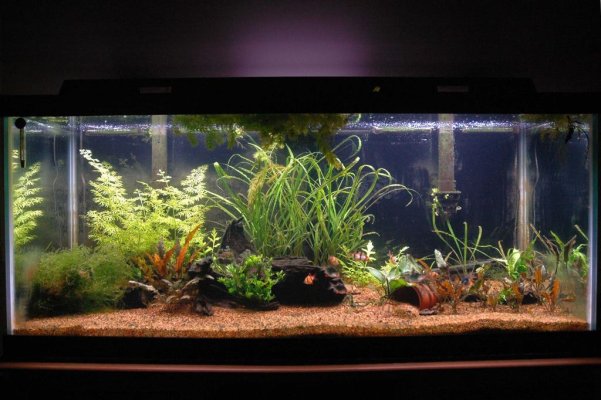vthokie
Aquarium Advice Apprentice
I have a 75 low-light tank with crypts (spiralis & wendtii), anubias, java moss, java fern, java lace, water sprite and hornwort. I had some deficiency problems (previous post) which have been improving since I began dosing. Most plants are doing well.
I have 2 issues at the moment:
1) Every day I find a couple of leaves from the crypt spiralis that have detached from the base. At first I thought it was just older leaves that were covered in algae from when I set up the tank, but now I've noticed that newer leaves are detaching as well. The Seachem Potassium bottle suggests that those are symptoms of potassium deficiency.
2) I have some BBA and some green spot algae. Nothing too bad...yet, but the BBA does seem to be spreading. I suspect this may be due to low nitrates & phosphates. I have not done a PWC for 4 weeks hoping to build up the nitrates, but they have remained the same.
I would consider the tank to be moderately planted.
I have most of the Seachem ferts except trace but I've been very conservative in my dosing so far since I have a fear that I'm going to make things worse!
The numbers:
light: 2-55W CF bulbs
substrate: fine gravel
pH: 7.4
Ammonia: 0
Nitrites: 0
Nitrates: 5ppm
Phosphates: 0.1ppm
GH: 6
KH: 3
Temp: 78F
Fish load: 19 small-med. tiger barbs, 1 blue gourami, 1 rainbow shark (all doing great)
I have also added sponges to the HOB outflow to reduce surface agitation to reduce loss of CO2.
Dosing:
Flourish Potassium: 12.5ml two times weekly
Flourish Comprehensive: 7.5ml two times weekly
Flourish Excel: 8.75 once per week
Flourish Iron: 7.5ml once per week
Flourish Nitrogen: 2ml (just one dose so far)
Flourish Phosphorous: 2ml (just one dose so far)
Flourish Fert tabs
No added CO2
Any suggestions on how to resolve these problems? Should I go heavy on the nitrogen/phosphorous dosing to control the BBA? Will increasing potassium prevent the leaves from falling?
Thanks for any help!
I have 2 issues at the moment:
1) Every day I find a couple of leaves from the crypt spiralis that have detached from the base. At first I thought it was just older leaves that were covered in algae from when I set up the tank, but now I've noticed that newer leaves are detaching as well. The Seachem Potassium bottle suggests that those are symptoms of potassium deficiency.
2) I have some BBA and some green spot algae. Nothing too bad...yet, but the BBA does seem to be spreading. I suspect this may be due to low nitrates & phosphates. I have not done a PWC for 4 weeks hoping to build up the nitrates, but they have remained the same.
I would consider the tank to be moderately planted.
I have most of the Seachem ferts except trace but I've been very conservative in my dosing so far since I have a fear that I'm going to make things worse!
The numbers:
light: 2-55W CF bulbs
substrate: fine gravel
pH: 7.4
Ammonia: 0
Nitrites: 0
Nitrates: 5ppm
Phosphates: 0.1ppm
GH: 6
KH: 3
Temp: 78F
Fish load: 19 small-med. tiger barbs, 1 blue gourami, 1 rainbow shark (all doing great)
I have also added sponges to the HOB outflow to reduce surface agitation to reduce loss of CO2.
Dosing:
Flourish Potassium: 12.5ml two times weekly
Flourish Comprehensive: 7.5ml two times weekly
Flourish Excel: 8.75 once per week
Flourish Iron: 7.5ml once per week
Flourish Nitrogen: 2ml (just one dose so far)
Flourish Phosphorous: 2ml (just one dose so far)
Flourish Fert tabs
No added CO2
Any suggestions on how to resolve these problems? Should I go heavy on the nitrogen/phosphorous dosing to control the BBA? Will increasing potassium prevent the leaves from falling?
Thanks for any help!

